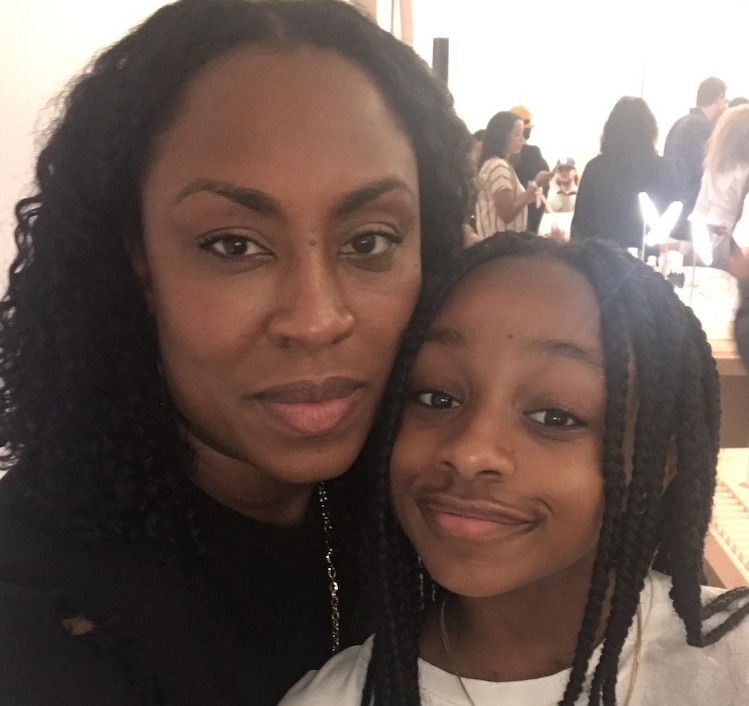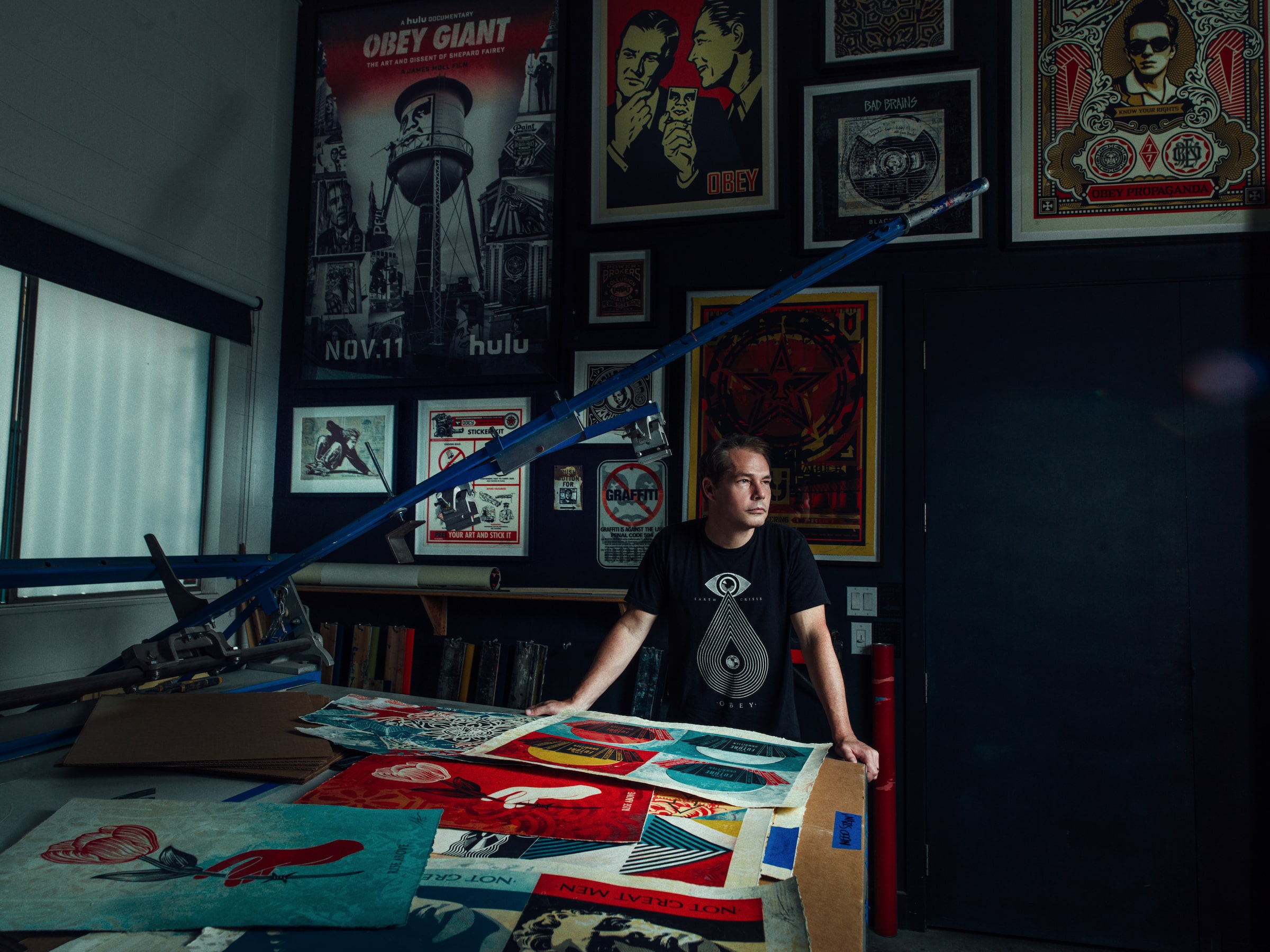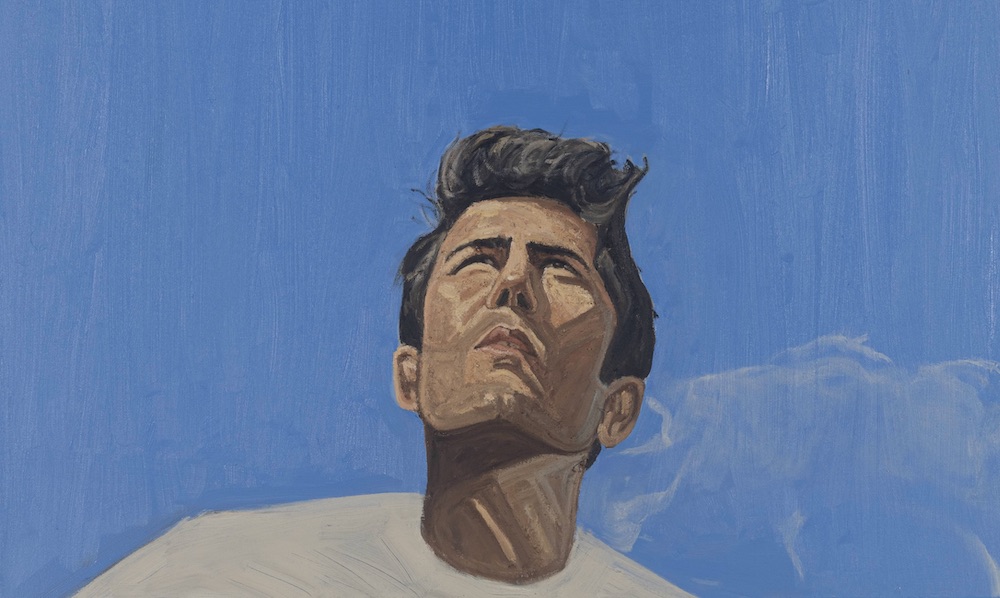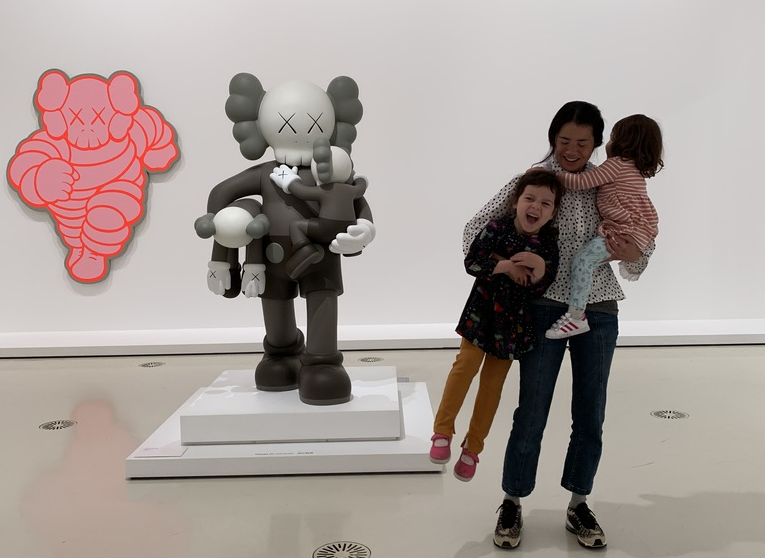Tiana Webb Evans lives by the mantra that you can have it all, just not at the same time. The brand and communications strategist and founder of Yard Concept has been a force in the art and design worlds for 20 years. (And full disclosure, I’ve known and loved her for close to a dozen of those years!).
Evans first became a mother while working as the business director of a downtown design firm in New York in the early 2000s. She’s held positions at Phillips and Merrill Lynch, curated shows, and established ESP Group. Then and now, she’s sought out the support of her cohort of mothers and colleagues in the creative world. Now a mom of three—all in high school or college—Evans is ready for what’s next.
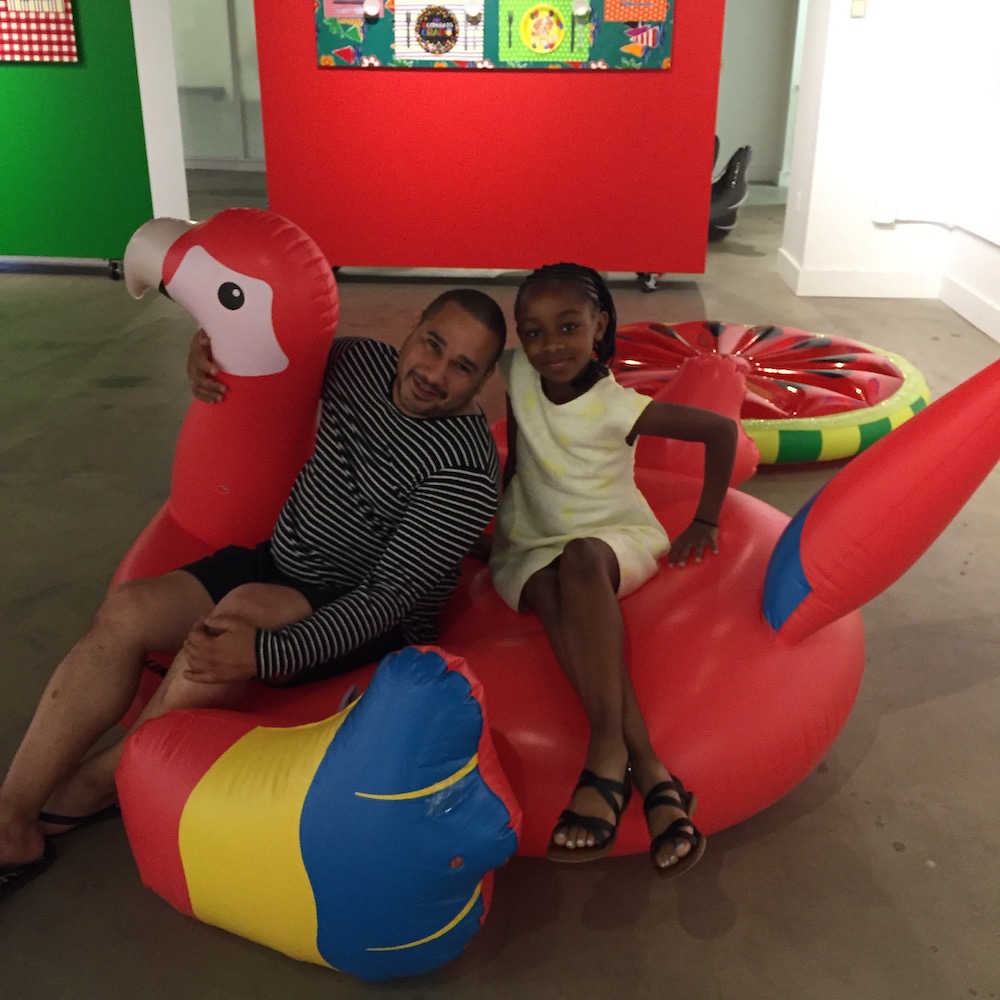
Evans’ daughter with David Antonio Cruz at Derrick Adams’s CULTURE CLUB exhibition at Project for Empty Space.
An integral part of her next chapter is Yard Concept—a social practice and platform made up of a digital journal, gallery, shop, and happenings. It’s a reflection of her community and this moment.
For the latest in our Art Mamas series, Evans shares her insights into the realities of motherhood. We discuss surrendering yourself to a new way of life, finding clarity of purpose professionally and at home, and the work of raising capable, engaged, and loving humans.
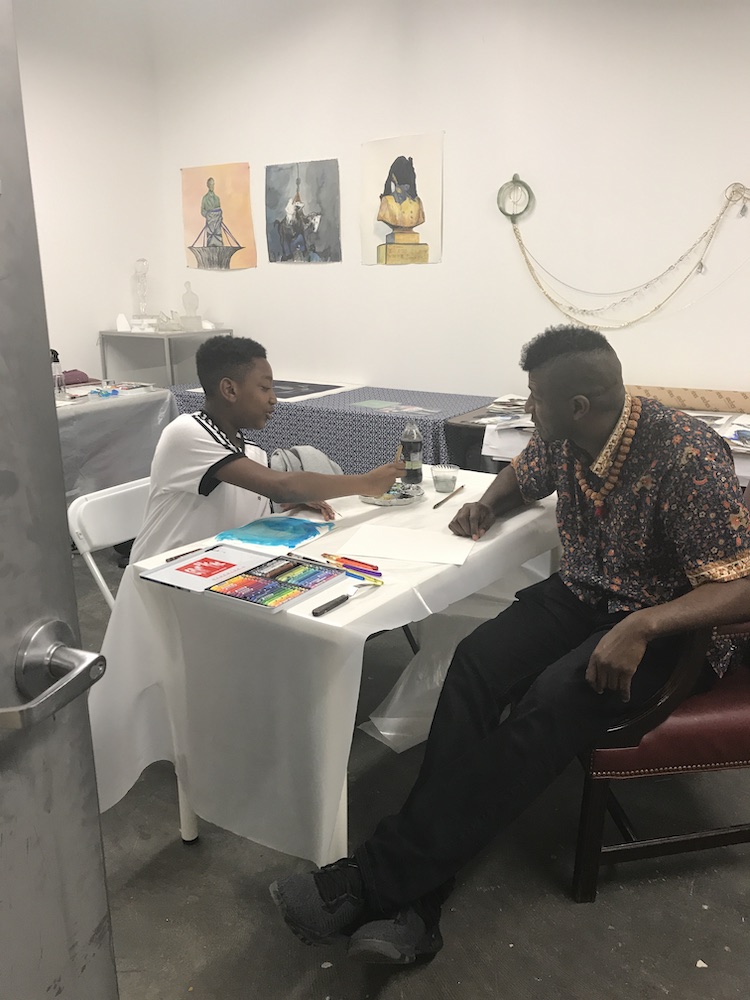
Evans’ middle son with AIR Kambui Olujimi during PES Open Studios.
WHITEWALL: When did you first become a mom?
TIANA WEBB EVANS: We were the first in our cohort of married friends to have a baby. I was 25, which now feels very young. We were lucky, we had a solid group of young coupled people coming out of college. They were my husband’s friends, but 20 years later I consider them family.
WW: How did you feel then?
TWE: I knew I chose the right partner. I was always very ambitious but one thing I accepted early on was that finding someone to share a future with was going to be a lot harder than finding a professional opportunity. So I chose love and family over a number of options. Now I have three children and I am still married 20 years later, which leads me to believe it was indeed an excellent decision.
WW: So true! At the time, were you able to take maternity leave?
TWE: With child number one, I was working at a small but growing design firm. The timing was an issue because I found out I was pregnant just as I was appointed the business director of the firm. By the time I hit my stride in this new role I was getting ready to go on maternity leave, which was not ideal. I was also the first person to have a baby in the firm. There was no maternity leave policy at that point. In fact, it was my responsibility to write one!
Maternity leave was chaotic. I wasn’t the least bit realistic about what it meant to be a mother and the demands on my time. I was (and still am) a workaholic, so stepping away from work was challenging. I only had a couple of weeks off and my temporary replacement was a flop. I was an integral part of a rapidly growing a small business. We just landed major contracts with Gucci Group and the firm’s international project portfolio exploded. I didn’t have the opportunity to really enjoy time with my newborn. The truth is you have to surrender yourself and learn a new way of existing in the world. Everything changes.
WW: Everything! What was it like when you went back to work?
TWE: It was a different world back then. I’m talking about 20 years ago when there was no social media or cultural appetite for intimate sharing. At the time I discovered people generally don’t have empathy for mothers. Especially childless, ambitious, creative people whose work is their life and their life is work.
I would leave work at seven o’clock in the evening and people would say, “Oh, so you’re taking a half-day?” As someone who is passionate about her work, it was disheartening. Especially because we were all friends and the studio was generally a supportive environment. Nevertheless, culture was that of martyr-like 12-hour workdays.
Much has changed since then and we are all very close and connected to this day.
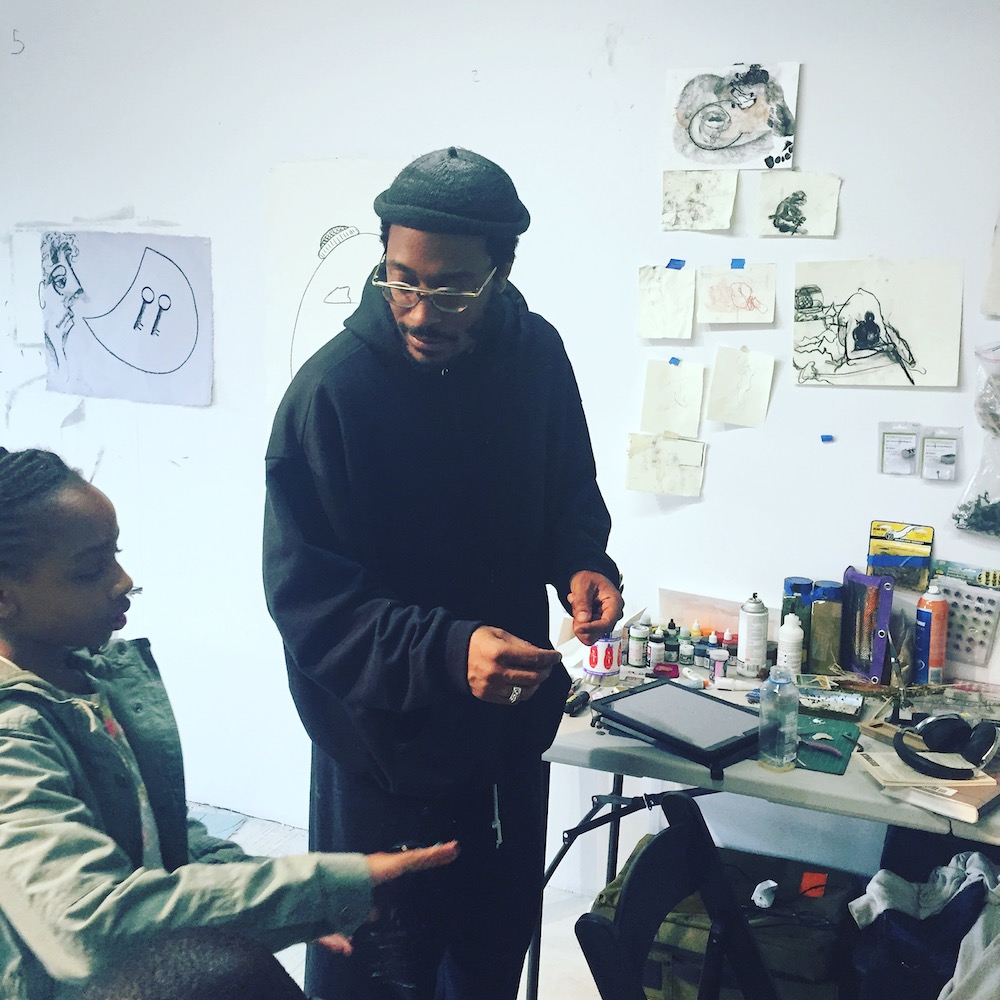
Evans’ daughter with Curtis Santiago at Pioneer Works.
WW: What surprised you the most about becoming a mother?
TWE: Loving someone so much was as jarring as it was thrilling. Nothing matters more than this little human. It’s like your heart is walking outside of your body. The vast amount of emotional and physical stamina that’s required to be a parent was surprising, as well. Children will take as much time and attention as they possibly can from you. There is never enough time.
Then you add to the fact that I am the type of mother who wants to be in that zone with them all the time. The depth of engagement spiritually, mentally, emotionally, and physically is unreal—they take over your whole being. By the time you’re on to your second child, you’re an expert, so the experience is more about the new baby’s personality without the background noise of your personal transformation.
Another unexpected part of motherhood is how your core values take center stage. It is impossible to gloss over the ideas and character traits that are important to you when you’re responsible for composing and constructing the life of a human. You’re faced with confronting all that really matters to you, and you better hope your partner is on the same page.
There is a constant spotlight on your behavior because you’re the model and they are watching 24/7. It seems obvious but most people forget how closely their children are paying attention to their every move.
WW: For your second pregnancy, did you feel more prepared going into it?
TWE: Yes, it was magical. With the first, I was afraid of failing. I didn’t want to break him. But with the second, I was like, “Yes go play in the grass! Be free!” I didn’t miss a beat with number two. I really enjoyed the experience.
I also was in a very different situation. I spent a few years in wealth management at Merrill Lynch. Although Merrill was a high-pressure environment, it was a large corporation and it had a strong maternity leave policy. Strangely, the testosterone-filled office was a lot more manageable than the downtown design firm. Although I missed my dynamically creative colleagues, sexy clients, and my chic office, it was a privilege to have more balance. My quality of life was 100% different. I was working full-time, I was close to home, and I was truly able to embrace motherhood.
WW: You mentioned that when you had your first, no one else in your group of friends had any children. So, who did you connect with?
TWE: When my first son was about three-years-old, we moved to the suburbs. I was able to connect with new groups of mothers there. As a result of these friendships, I was then invited to a national mother’s organization and from there my community blossomed exponentially.
I would say I live three lives: my art life, my design life, and my suburban life. My mommy support comes from the mother’s organization I’ve been a part of for 13 years and my neighborhood friends. These women are very special to me and have provided legendary support as I re-entered the industries I love.
As my eldest was heading into middle school, I was Communications Director at Phillips Auctioneers and working in London a couple of weeks a year. My village was on the job! My son describes it as having “eyes and ears” everywhere. He would be astounded by the fact that I always knew what was happening and where he was although I was in another country. He’s almost 20 and it’s still something we laugh about. A loving and supportive community is absolutely essential if you are going to have a demanding career and a thriving family.
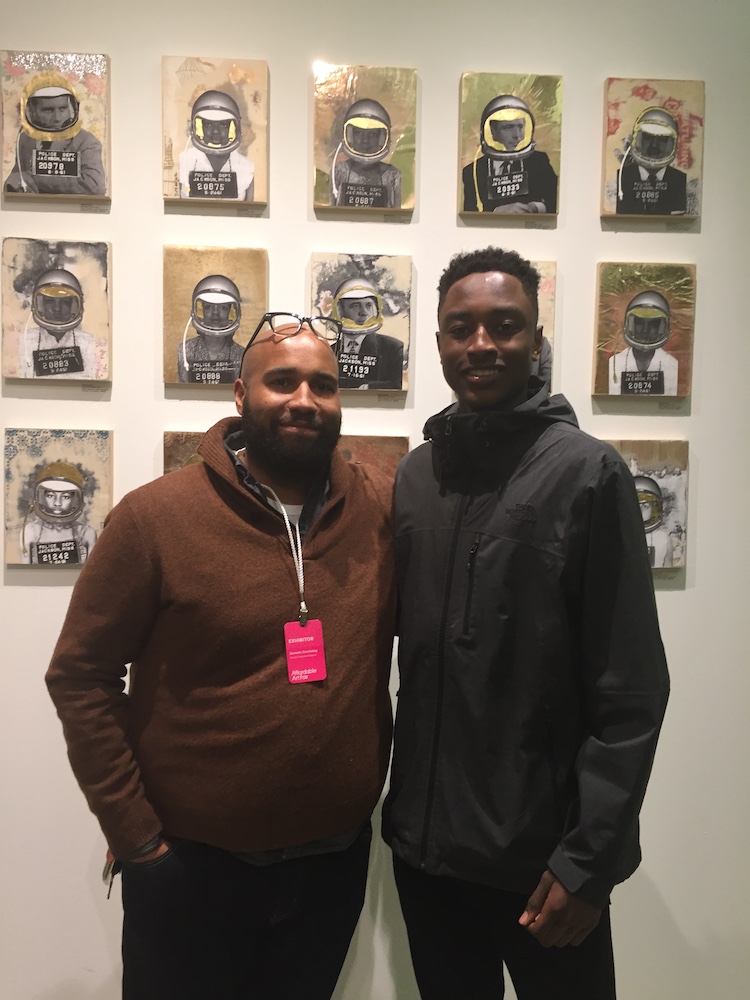
Evans’ eldest son with Delano Dunn at the Affordable Art Fair.
WW: How do you navigate your career choices, with family as a factor in that equation?
TWE: The honest answer is my mother was extremely ambitious and before her time. She had an airplane charter company and a hotel. My mother is 80 so we’re talking about a woman of color in the 1970s and ‘80s with big, bodacious aspirations. I knew, based on personal experience, as the child of a fearless woman with big dreams, that one person can’t do it all. It’s just that simple. A mom entrepreneur needs a tribe of people who are invested in her and her children.
I married a womanist. He is the son of an artist whose legacy is one of uncompromising strength and self-determination. We are yin and yang, so there is always a balance of energies. When the kids were little, he was the globe-trotter, and then the roles reversed when my young children entered elementary school. It wasn’t planned that way, but it has worked out so there has always been a primary caregiver front-and-center at home.
WW: What prompted your next move, as a publicist in the art world?
TWE: I knew I would go deeper into the art world but it took me a number of years to figure out where I could fit. I wanted to participate in history, that was a driving idea for me. From there I took stock of the industry: Who are the players? How does one create value?
I was really interested in either being a curator or a dealer but at that time there was no framework of support for a mother of three, with the added challenge of being a black woman, to perform at a high level in either capacity. I was introduced to public relations and quickly understood how the model could work for me and within the parameters of my life. I figured, if I could be a catalyst for a person or project’s success and be part of shaping a broader cultural conversation, then I am doing something worthwhile; something with impact. I jumped at the opportunity. Needless to say, it has served me well for over a decade.
WW: As your children have grown up, how have you shared the art world with them?
TWE: When my eldest was three, I curated an exhibition at Wilmer Jennings Gallery, a treasure of an art space owned by Corinne Jennings and the late Joe Overstreet, on the Lower East Side. He was by my side through the whole process because I was working full-time and would pick him up from pre-school and head to the gallery. He was a very charming gallery assistant. I still believe he was the reason I was able to sell so much work!
When my youngest was about six, I realized having a daughter was a bit different because she wanted to hang out with me all the time. I started taking her to museums and galleries. One Sunday we went to visit with then Studio Museum of Harlem curator Naima Keith for the AIR Open Studio session and my daughter fell in love with Kevin Beasley’s work. We were tickled when she started drilling him with questions.
About a week and a half later, I get an email asking if she wants to interview Kevin for Studio Magazine! So she ends up interviewing Kevin, Toyin Ojih Odutola, and a few others. “Mini Curator” was born, thanks to Naima Keith and Thelma Golden. Then she started going to art fairs with me and hanging out with me when I was working. She has a group of very committed art aunties like Deb Willis, Helen Toomer, Jasmine Wahi, Rebecca Jampol, and her art uncle Larry Ossei-Mensah.
Over the years we’ve had artists present work at the house or curators over for meals. This is where my middle child shines because he’s a homebody and loves the theater of hosting—plus he’s a great cook.
At this stage, with everyone on the runway to college (or away at college) these happenings don’t occur as often as they used to. We’re now managing many separate agendas. Nevertheless, I hope these experiences stay with them as they mature and they, at the very least, become committed art patrons.
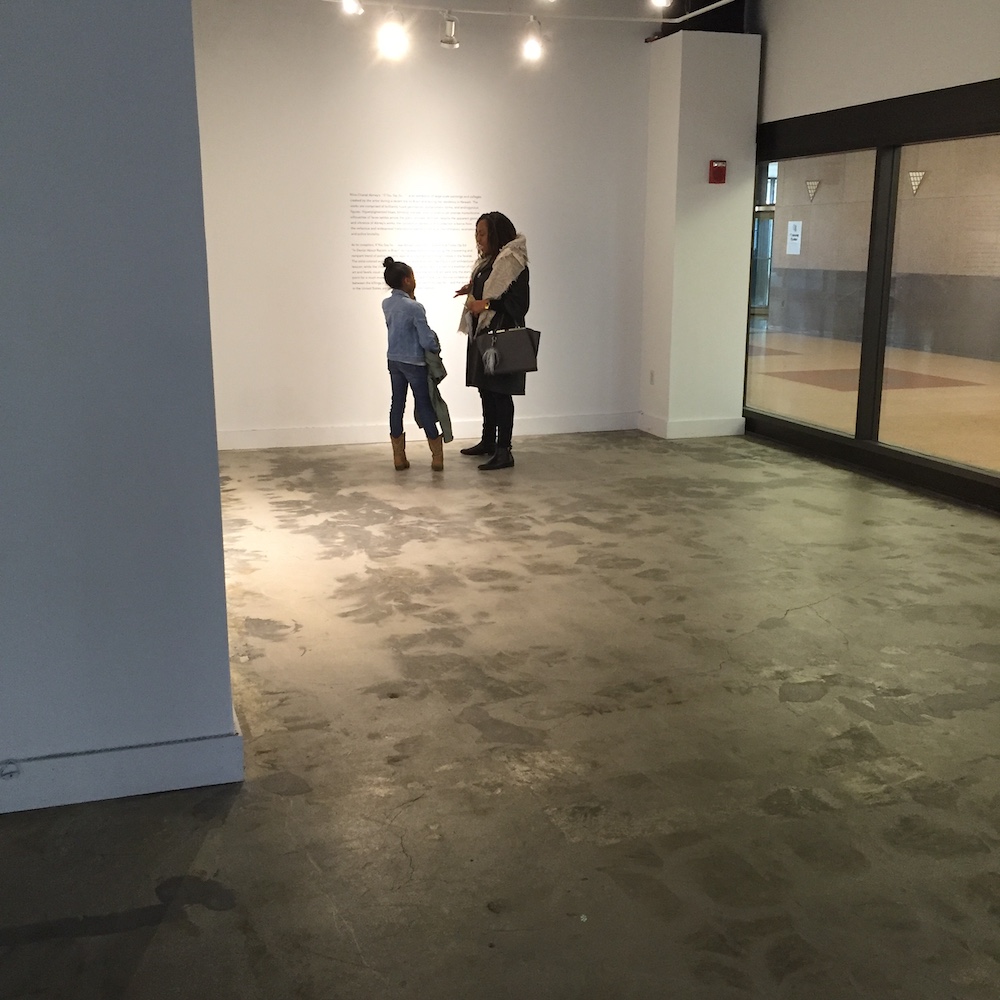
Evans and her daughter at Project for Empty Space, analyzing the wall text.
WW: Is there something another mother has shared with you that has really resonated?
TWE: I’ve been very fortunate to always have a loving, supportive, robust community. I can’t stress it enough. You need to be connected to people who are in a similar stage of life. You need to find a group of mothers to support you. Like your Art Mamas group—it’s marvelous.
The parents of one of my husband’s oldest friends, who at the time had been married for some 30 years, used to host dinners for us newlyweds to talk about marriage in their beautiful Bed-Stuy brownstone. Upon reflection, I think it was group marital counseling but they never quite explained it that way—the good food and wine were great distractions. One evening the hostess, who I believe was a high school principal at the time, said something I’ve kept close to my heart since that moment: “You can have it all but not at the same time.”
This simple statement has carried me through what will be 20 years of motherhood in July. When you’re at the beginning of the journey, it feels like it’s going to be forever before you can be your full self again. And if you start the parenting journey later in life, meaning you’ve already established a career, and you now have to take a pause, understand there is more to the story. Take a few quiet moments and map out a plan so that it doesn’t feel like everything has to happen at once.
I have mapped my career trajectory to align my kids’ collective stages of development. Between fifth grade and ninth grade, your children are processing the world outside of the scope of their parents’ identities for the first time. They start to see themselves as separate, then the group think starts, followed by the rollercoaster of teenage self-definition. Needless to say, it is a critical time to be fully engaged. The intensity requires a similar level of stamina to that of having a newborn.
When my kids were in elementary school I was flying back and forth to London for work. It wasn’t ideal but they had stable support and infrastructure at home. We had a team—my husband, my mother, friends, and a babysitter who is basically like family—and could work all kinds of magic in a bind.
As a mother, you’re not judged on what you’ve accomplished, how many magazines you’ve been in, or how many amazing people you’re in contact with. Your kids don’t care about any of it! They want to know, am I safe? Am I happy? Is Mommy paying attention to me? Do my parents love me? Do I have lunch in my backpack and a proper meal? Did they show up to my recital? Did they show up to my game? Zero to 18, it’s all that matters.
WW: Oh, you are giving me chills! And tears. My son is just over a year so I am taking notes!
What I’m hearing from you is that it’s OK to hold tight. Tiana, by the way, you’ve done amazing things and I’m totally impressed by what you’ve accomplished already in your career. I know you have grand visions and I can’t wait for what’s next.
As someone at the beginning of my motherhood journey, hearing you say, “You can have it all but not all at the same time,” I’m reassured. Our careers are long. So thank you.
TWE: Managing your time is the key to sanity. If you’re the kind of mother or primary caregiver that is a creative or producer, you might not have time for many girl’s nights out or to binge-watch Netflix. You have to look at your schedule in a way that prioritizes your family first and your dreams second. Sorry, friends don’t come first when you make the choice to grow humans.
There are a lot of things that I don’t do. There is always a sacrifice, which goes beyond motherhood; it is just the law of the universe. You must have clarity of purpose and intention to have peace and, in this case, offer peace to your family.
The other thing that’s very important is to just keep moving forward. So, let’s say you have a regular job but dream of being an independent curator. Write a little bit about your exhibition, start looking at artists. You can spend two hours a week, three hours a week. Those are your special three hours where you’re going to write, or do your research, or read. You have to manage your schedule—do whatever little bit you can. It all adds up.
As my youngest enters high school, the time has come for me to activate my next series of plans. It is an exciting moment for me.
WW: So speaking of manifesting, you’ve got to tell me about what you’re working on now, Yard Concept.
TWE: Yard Concept is a social practice and an elevation platform with the aim of fostering critical consciousness. It manifests in a digital journal, gallery, shop, and happenings. There is so much noise in the world, so much aimed to throw and dull our senses, to be automatons and abject consumers. All this noise robs us of the ability to connect to our true selves, our spiritual selves, our creative selves, and the source of ourselves.
Every issue is themed and a kaleidoscope of people from all aspects of my life lend their thoughts and talents to this project. I am so very grateful for all of the genius in my midst.
One of the most exciting developments from this work are the Yard Concept Reading Circles which pre-quarantine were hosted by Gavin Brown’s enterprise in Harlem. We explore texts that are timely, even if they might have been written 20 or 30 years prior, and bring a conversation that might have only existed in an academic setting to the public in an open forum. They just started last year and we host them quarterly. It’s a circle with complete strangers most of the time, talking about things that are very intimate, sometimes abstract. The hope is that we’re inspiring a new love for intellectual engagements, ideas are sparked, and people take what they need from the conversation.
We’ve been hosting reading circles virtually since quarantine, which has allowed us to have people from all over the country, as well as some international guests, but we hope to be back in a physical circle soon.
We are committed to the idea of togethering.
WW: It’s like a self-portrait.
TWE: Maybe like a community portrait. Like a portrait of the moment.


